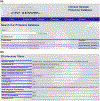Exploiting the proteomics revolution in biotechnology: from disease and antibody targets to optimizing bioprocess development
- PMID: 24997444
- PMCID: PMC9536114
- DOI: 10.1016/j.copbio.2014.06.006
Exploiting the proteomics revolution in biotechnology: from disease and antibody targets to optimizing bioprocess development
Abstract
Recent advancements in proteomics have enabled the generation of high-quality data sets useful for applications ranging from target and monoclonal antibody (mAB) discovery to bioprocess optimization. Comparative proteomics approaches have recently been used to identify novel disease targets in oncology and other disease conditions. Proteomics has also been applied as a new avenue for mAb discovery. Finally, CHO and Escherichia coli cells represent the dominant production hosts for biopharmaceutical development, yet the physiology of these cells types has yet to be fully established. Proteomics approaches can provide new insights into these cell types, aiding in recombinant protein production, cell growth regulation, and medium formulation. Optimization of sample preparations and protein database developments are enhancing the quantity and accuracy of proteomic results. In these ways, innovations in proteomics are enriching biotechnology and bioprocessing research across a wide spectrum of applications.
Copyright © 2014 Elsevier Ltd. All rights reserved.
Figures


References
-
- Frei AP, Jeon OY, Kilcher S, Moest H, Henning LM, Jost C, Pluckthun A, Mercer J, Aebersold R, Carreira EM et al.: Direct identification of ligand–receptor interactions on living cells and tissues. Nat Biotechnol 2012, 10:997–1001. - PubMed
-
- Cheung WC, Beausoleil SA, Zhang X, Sato S, Schieferl SM, Wieler JS, Beaudet JG, Ramenani RK, Popova L, Comb MJ et al.: A proteomics approach for the identification and cloning of monoclonal antibodies from serum. Nat Biotechnol 2012, 30:447–452. - PubMed
-
- Wine Y, Boutz DR, Lavinder JJ, Miklos AE, Hughes RA, Hoi KH, Jung ST, Horton AP, Murrin EM, Ellington AD et al.: Molecular deconvolution of the monoclonal antibodies that comprise the polyclonal serum response. PNAS 2013, 110:2993–2998. - PMC - PubMed
-
The authors describe a novel methodology to determine antibody composition of the polyclonal serum response by use of antigen-affinity chromatography coupled to tandem mass spectrometry. The protocol offers new insights into understanding the antibody immune response.
Publication types
MeSH terms
Grants and funding
LinkOut - more resources
Full Text Sources
Other Literature Sources

